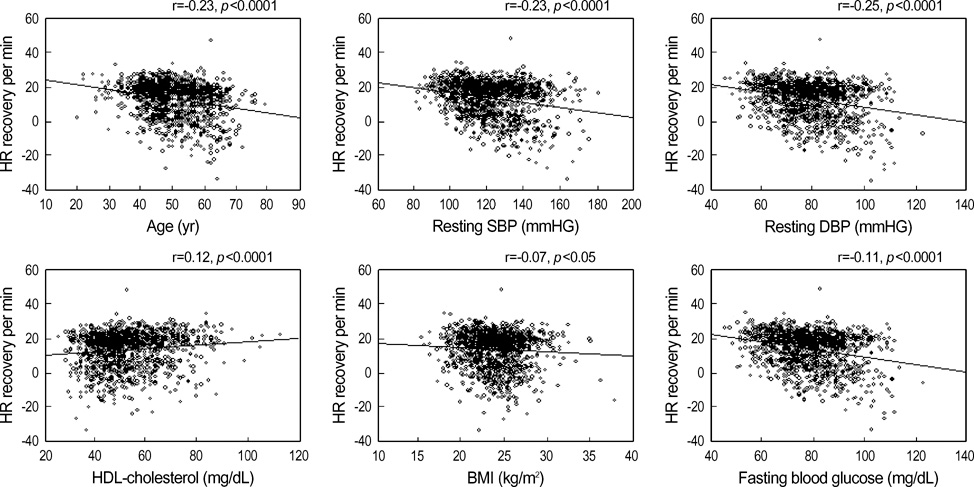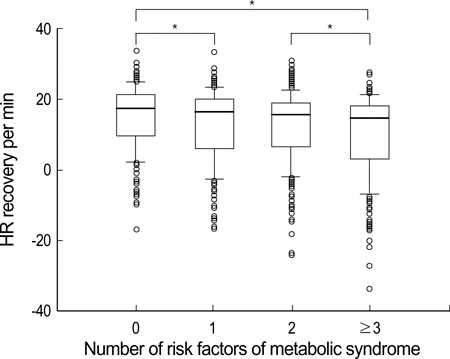J Korean Med Sci.
2006 Aug;21(4):621-626. 10.3346/jkms.2006.21.4.621.
Metabolic Syndrome Is Associated with Delayed Heart Rate Recovery after Exercise
- Affiliations
-
- 1Center for Health Promotion, Samsung Medical Center, Sungkyunkwan University School of Medicine, Seoul, Korea.
- 2Department of Medicine/Cardiology, Cheil General Hospital, Sungkyunkwan University School of Medicine, Seoul, Korea. parkjb@skku.edu
- KMID: 2157811
- DOI: http://doi.org/10.3346/jkms.2006.21.4.621
Abstract
- Heart rate (HR) recovery after exercise is a function of vagal reactivation, and its impairment is a predictor of overall mortality and adverse cardiovascular events. While metabolic syndrome is associated with sympathetic overactivity, little is known about the relationship between metabolic syndrome and HR recovery. A symptom-limited exercise stress test in healthy subjects (n=1, 434) was used to evaluate HR recovery. Metabolic syndrome was defined according to the National Cholesterol Education Program's Adult Treatment Panel III (NCEP ATP-III) criteria. Seventeen percent of subjects had > or =3 criteria for metabolic syndrome. HR recovery was lower in men than women and in smokers than nonsmokers. The subject with metabolic syndrome (vs. without) showed lower HR recovery (10.3+/-11.6 vs. 13.6+/-9.7 per minute) and higher resting HR (64.3+/-10.3 vs. 61.6+/-9.1 per minute). HR recovery correlated inversely to age (r=-0.25, p<0.0001), but not to resting HR or maximal oxygen uptake. Delayed HR recovery was associated with metabolic syndrome after an adjustment for age, sex, resting HR and smoking (p<0.01). Metabolic syn-drome is associated with impaired vagal reactivation. Adverse cardiovascular out-comes associated with metabolic syndrome may be mediated by the failure of vagal reactivation in addition to sympathetic overactivity.
MeSH Terms
-
Walking/physiology
Smoking
Sex Factors
Oxygen Consumption/physiology
Middle Aged
Metabolic Syndrome X/blood/*physiopathology
Male
Humans
Heart Rate/*physiology
Female
Fasting/blood
Exercise/*physiology
Cholesterol, HDL/blood
Body Mass Index
Blood Pressure/physiology
Blood Glucose/metabolism
Analysis of Variance
Age Factors
Adult
Figure
Reference
-
1. Cole CR, Blackstone EH, Pashkow FJ, Snader CE, Lauer MS. Heart rate recovery immediately after exercise as a predictor of mortality. N Engl J Med. 1999. 341:1351–1357.
Article2. Cole CR, Foody JM, Blackstone EH, Lauer MS. Heart rate recovery after submaximal exercise testing as a predictor of mortality in a cardiovascularly healthy cohort. Ann Intern Med. 2000. 132:552–555.
Article3. Morshedi-Meibodi A, Larson MG, Levy D, O'Donnell CJ, Vasan RS. Heart rate recovery after treadmill exercise testing and risk of cardiovascular disease events (The Framingham Heart Study). Am J Cardiol. 2002. 90:848–852.
Article4. Kim HS, Lee JH, Kwon YS, Lee HS, Yang DH, Park HS, Jo YK, Chae SC, Jun JE, Park WH. Changes in heart rate during and after exercise treadmill test as prognostic factor in cardiovascular disease. Korean Circ J. 2004. 34:170–177.
Article5. Ju DU, Kang HJ, Kim SW, No TM, Son HS, Kang BJ, Kim SR, Lee BR, Jung BC, Lee JJ. The difference of heart rate recovery in ischemic heart disease comparing to normal. Korean J Med. 2004. 66:586–592.6. Vivekananthan DP, Blackstone EH, Pothier CE, Lauer MS. Heart rate recovery after exercise is a predictor of mortality, independent of the angiographic severity of coronary disease. J Am Coll Cardiol. 2003. 42:831–838.
Article7. Cheng YJ, Lauer MS, Earnest CP, Church TS, Kampert JB, Gibbons LW, Blair SN. Heart rate recovery following maximal exercise testing as a predictor of cardiovascular disease and all-cause mortality in men with diabetes. Diabetes Care. 2003. 26:2052–2057.
Article8. Rosenwinkel ET, Bloomfield DM, Arwady MA, Goldsmith RL. Exercise and autonomic function in health and cardiovascular disease. Cardiol Clin. 2001. 19:369–387.
Article9. Arai Y, Saul JP, Albrecht P, Hartley LH, Lilly LS, Cohen RJ, Colucci WS. Modulation of cardiac autonomic activity during and immediately after exercise. Am J Physiol. 1989. 256:132–141.
Article10. Emdin M, Gastaldelli A, Muscelli E, Macerata A, Natali A, Camastra S, Ferrannini E. Hyperinsulinemia and autonomic nervous system dysfunction in obesity: effects of weight loss. Circulation. 2001. 103:513–519.11. Esler M, Rumantir M, Wiesner G, Kaye D, Hastings J, Lambert G. Sympathetic nervous system and insulin resistance: from obesity to diabetes. Am J Hypertens. 2001. 14:304S–309S.
Article12. Peterson HR, Rothschild M, Weinberg CR, Fell RD, McLeish KR, Pfeifer MA. Body fat and the activity of the autonomic nervous system. N Engl J Med. 1988. 318:1077–1083.
Article13. Lind L, Andren B. Heart rate recovery after exercise is related to the insulin resistance syndrome and heart rate variability in elderly men. Am Heart J. 2002. 144:666–672.
Article14. Gottsater A, Ahmed M, Fernlund P, Sundkvist G. Autonomic neuropathy in type 2 diabetic patients is associated with hyperinsulinaemia and hypertriglyceridaemia. Diabet Med. 1999. 16:49–54.
Article15. Kawahara E, Ikeda S, Miyahara Y, Kohno S. Role of autonomic nervous dysfunction in electrocardiographic abnormalities and cardiac injury in patients with acute subarachnoid hemorrhage. Circ J. 2003. 67:753–756.
Article16. Lindmark S, Wiklund U, Bjerle P, Eriksson JW. Does the autonomic nervous system play a role in the development of insulin resistance? A study on heart rate variability in first-degree relatives of type 2 diabetes patients and control subjects. Diabet Med. 2003. 20:399–405.
Article17. Laitinen T, Vauhkonen IK, Niskanen LK, Hartikainen JE, Lansimies EA, Uusitupa MI, Laakso M. Power spectral analysis of heart rate variability during hyperinsulinemia in nondiabetic offspring of type 2 diabetic patients: evidence for possible early autonomic dysfunction in insulin-resistant subjects. Diabetes. 1999. 48:1295–1299.
Article18. National Cholesterol Education Program (NCEP) Expert Panel on Detection, Evaluation, and Treatment of High Blood Cholesterol in Adults (Adult Treatment Panel III). Third Report of the National Cholesterol Education Program (NCEP) Expert Panel on Detection, Evaluation, and Treatment of High Blood Cholesterol in Adults (Adult Treatment Panel III) Final Report. Circulation. 2002. 106:3143–3421.19. Ferguson C, Myers J, Foroelicher V. PD T, editor. Overview of exercise testing. Exercise and sports cardiology. 2001. 1st ed. New York: McGraw-Hill;92.20. Borg G. Perceived exertion as an indicator of somatic stress. Scand J Rehab Med. 1970. 2:92–98.21. Spies C, Otte C, Kanaya A, Pipkin SS, Schiller NB, Whooley MA. Association of metabolic syndrome with exercise capacity and heart rate recovery in patients with coronary heart disease in the heart and soul study. Am J Cardiol. 2005. 95:1175–1179.
Article22. Scheurink AJ, Balkan B, Nyakas C, van Dijk G, Steffens AB, Bohus B. Energy homeostasis, autonomic activity and obesity. Obes Res. 1995. 3:Suppl 5. 721–727.
Article23. Rissanen P, Franssila-Kallunki A, Rissanen A. Cardiac parasympathetic activity is increased by weight loss in healthy obese women. Obes Res. 2001. 9:637–643.
Article24. Boden G, Hoeldtke RD. Nerves, fat, and insulin resistance. N Engl J Med. 2003. 349:1966–1967.
Article25. Palatini P. Elevated heart rate as a predictor of increased cardiovascular morbidity. J Hypertens. 1999. 17:Suppl 3. 3–10.26. Palatini P, Casiglia E, Pauletto P, Staessen J, Kaciroti N, Julius S. Relationship of tachycardia with high blood pressure and metabolic abnormalities: a study with mixture analysis in three populations. Hypertension. 1997. 30:1267–1273.27. Greenland P, Daviglus ML, Dyer AR, Liu K, Huang CF, Goldberger JJ, Stamler J. Resting heart rate is a risk factor for cardiovascular and noncardiovascular mortality: the Chicago Heart Association Detection Project in Industry. Am J Epidemiol. 1999. 149:853–862.
Article28. Mensink GB, Hoffmeister H. The relationship between resting heart rate and all-cause, cardiovascular and cancer mortality. Eur Heart J. 1997. 18:1404–1410.
Article29. Darr KC, Bassett DR, Morgan BJ, Thomas DP. Effects of age and training status on heart rate recovery after peak exercise. Am J Physiol. 1988. 254:340–343.
Article30. Tiukinhoy S, Beohar N, Hsie M. Improvement in heart rate recovery after cardiac rehabilitation. J Cardiopulm Rehabil. 2003. 23:84–87.
Article31. Holtzhausen LM, Noakes TD. The prevalence and significance of post-exercise (postural) hypotension in ultramarathon runners. Med Sci Sports Exerc. 1995. 27:1595–1601.
Article32. Shetler K, Marcus R, Froelicher VF, Vora S, Kalisetti D, Prakash M, Do D, Myers J. Heart rate recovery: validation and methodologic issues. J Am Coll Cardiol. 2001. 38:1980–1987.
Article33. Janssen I, Heymsfield SB, Allison DB, Kotler DP, Ross R. Body mass index and waist circumference independently contribute to the prediction of nonabdominal, abdominal subcutaneous, and visceral fat. Am J Clin Nutr. 2002. 75:683–688.
Article34. Shishehbor MH, Hoogwerf BJ, Lauer MS. Association of triglyceride-to-HDL cholesterol ratio with heart rate recovery. Diabetes Care. 2004. 27:936–941.
Article35. Krock LP, Hartung GH. Influence of post-exercise activity on plasma catecholamines, blood pressure and heart rate in normal subjects. Clin Auton Res. 1992. 2:89–97.
Article
- Full Text Links
- Actions
-
Cited
- CITED
-
- Close
- Share
- Similar articles
-
- The metabolic syndrome and sports medicine
- Effect of Yoga on Heart Rate Variability in Women with Metabolic Syndrome
- Heart Rate Responses at Rest, during Exercise and after Exercise Periods in Relation to Adiposity Levels among Young Nigerian Adults
- Postexercise Syncope in 6 Young Adults without Organic Heart Disease
- Slow Heart Rate Recovery Is Associated with Increased Exercise-induced Arterial Stiffness in Normotensive Patients without Overt Atherosclerosis




